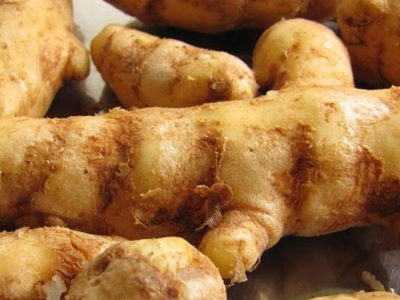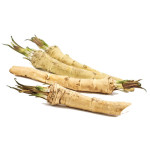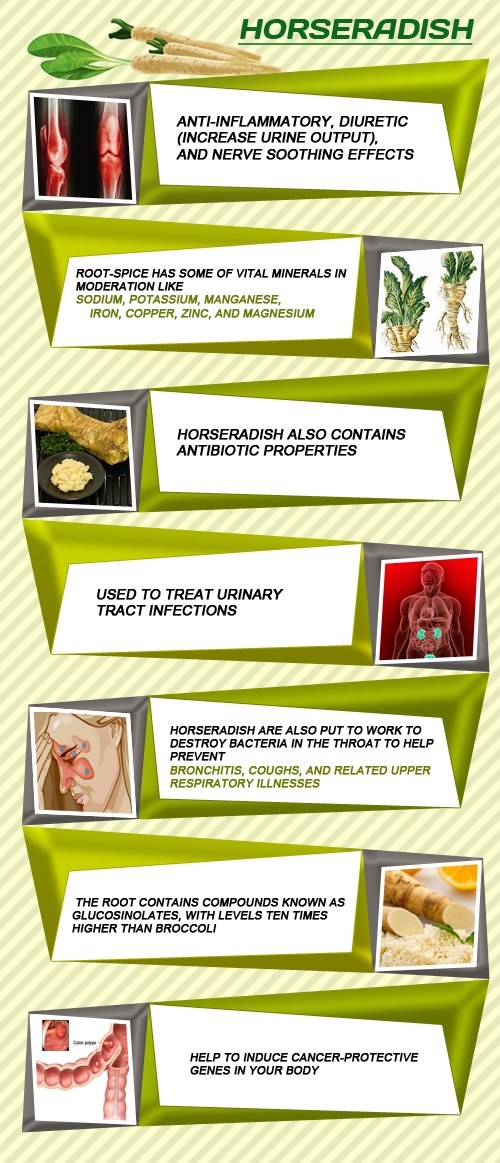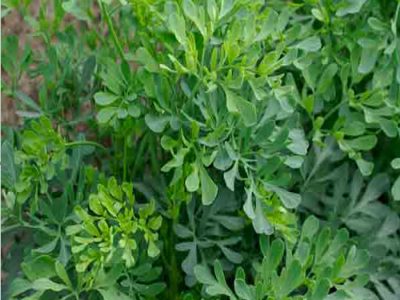

Horseradish Nutrition and Health Information
About Horseradish
Scientifically known as Armoracia rusticana horseradish belong to the same family as that of mustard and wasabi known as the Brassucaceae family. It is a white tap root holding its origin in the South Eastern Europe and western parts of Asia. During 1500 B.C the Egyptians were using horseradish in both its culinary and medicinal purposes. The Greeks used it as an aphrodisiac and the Romans used it as a herb.It has derived its name from German word called ‘’meerretich’’ which means growing by the sea, eventually it was named horseradish because of its coarse and hard nature; radish comes from a Latin word radix meaning root. Horseradish as introduced to America by the English men; in 1850’s the commercial cultivation of this taproot grew rapidly in and Mississippi river where the soil was fertile enough for its cultivation. After World War II other regions of California and Wisconsin started horseradish cultivation and today a remarkable amount of horseradish is produced by U.S.A accounting up to 6 million gallons of this vegetable is grown annually. Horseradish is an easy to grow perennial plant as grows once in a year but it is made available throughout the year. The growing condition of this plant needs a full sun with water logged soil condition.
Horseradish Nutritional Value
[tribulant_slideshow gallery_id="34"]
- Horseradish also contains Antibiotic Properties.
- Used to treat urinary tract infections.
- Root-spice has some of vital minerals in moderation like sodium, potassium, manganese, iron, copper, zinc, and magnesium.
- Horseradish also contains several important antioxidants, including quercetin, rutin, and sinapic acid. These antioxidants help protect the body from oxidative damage caused by free radicals. Horseradish also contains glucosinolates, which are beneficial compounds that help to support the immune system and lower inflammation.
- Horseradish has been used for centuries as a digestive aid. It can help to stimulate the digestive system, making it easier to digest food. It also helps to reduce gas and bloating. Horseradish can also help to improve liver function, and it has been linked to a lower risk of cardiovascular disease.
- Horseradish is also a good source of calcium, providing 4% of the daily value in a single tablespoon. Calcium is important for strong bones and teeth, and for muscle and nerve function. It also helps to regulate blood pressure and prevent heart disease.
- Horseradish is a highly nutritious condiment. It is a good source of vitamin C, dietary fiber, antioxidants, and calcium. It also has many health benefits, including improved digestion, a lower risk of cardiovascular disease, and improved immune function. For these reasons, horseradish is an excellent addition to any diet.
Horseradish Benefits
- Horseradish are also put to work to destroy bacteria in the throat to help prevent bronchitis, coughs, and related upper respiratory illnesses.
- The root contains compounds known as glucosinolates, with levels ten times higher than broccoli.
- Horseradish is rich in Vitamin C, which helps boost immunity and fight off infection. It is also a good source of fiber, potassium, and magnesium. The vegetable contains a variety of antioxidants which can help reduce inflammation. It has been used as a traditional remedy for respiratory ailments like bronchitis and asthma. Horseradish is also rich in glucosinolates, which are associated with a decreased risk of cancer.
- Horseradish is known to be an excellent source of dietary nitrates, which can help improve exercise performance. Nitrates can reduce the oxygen cost of exercise, increase exercise endurance, and reduce blood pressure. Studies have also shown that consuming horseradish can reduce the risk of cardiovascular disease.
- Horseradish is a versatile vegetable that can be used in many dishes. It can be grated, pureed, and added to many dishes like salads, soups, and sauces. It is also a great addition to sandwiches, burgers, and pizzas. Horseradish can also be used as a condiment, and it pairs well with fish, meat, and vegetables.
- Horseradish is a tasty and nutritious vegetable that can be enjoyed in many ways. It is an excellent source of Vitamin C, fiber, and a variety of antioxidants. Horseradish can also help reduce inflammation, improve exercise performance, and reduce the risk of cardiovascular disease. Whether you enjoy the spicy flavor or use it as a condiment, horseradish is a great addition to any meal.
- Help to induce cancer-protective genes in your body.
| Principle | Nutrient Value | Percentage of RDA |
| Energy | 48 cal | 2% |
| Carbohydrates | 11.29 g | 9% |
| Protein | 1.18 g | 2% |
| Total Fat | 0.69 g | 3% |
| Cholesterol | 0 mg | 0% |
| Dietary Fiber | 3.3 g | 9% |
| Vitamins | ||
| Folates | 57 µg | 14% |
| Niacin | 0.386 mg | 2.5% |
| Pantothenic acid | 0.093 mg | 2% |
| Pyridoxine | 0.073 mg | 6% |
| Riboflavin | 0.024 mg | 2% |
| Thiamin | 0.008 mg | <1% |
| Vitamin A | 2 IU | <1% |
| Vitamin C | 24.9 mg | 41% |
| Electrolytes | ||
| Sodium | 314 mg | 21% |
| Potassium | 246 mg | 5% |
| Minerals | ||
| Calcium | 56 mg | 6% |
| Copper | 0.058 mg | 6% |
| Iron | 0.42 mg | 5% |
| Magnesium | 27 mg | 7% |
| Manganese | 0.126 mg | 5.5% |
| Phosphorus | 31 mg | 4.5% |
| Zinc | 0.83 mg | 8% |
| Phyto-nutrients | ||
| Carotene-ß | 1 µg | — |
| Crypto- xanthin-ß | 0 µg | — |
| Lutein- zeaxanthin | 10 µg | — |
Horseradish is known for its fiery taste but there is more to it; this food that is usually used as condiment has health benefits that many foods lack in. Like other cruciferous Horseradish has anti cancer properties in it. Glucosinolate a compound present in horseradish is used to fight cancer cells and horseradish is considered to have 10 times more glucosinolate when compared to broccoli and other cruciferous vegetables. Horseradish has been used as an age old remedy for sinus, horseradish consumed as a sauce or powdered form creates a sensation in the body and thus clearing sinus formed in form of sweating or tearing. Owing to its anti bacterial properties it is also known for its remedial properties of treating urinal infections.
How To Enjoy Horseradish
Horseradish is sold in small jars in supermarket and sometimes alsoin flavoured sauces such as dips, mayonnaise and hot sauces.There are numerous possibilities with horseradish it is served as a accompaniment to beef steaks and it is a classic combination. Grating a horseradish can be a tough task as it has so much heat in it that it emits fumes when you peel the outer skin of it and leaves with irritated eyes and nose. Care should be taken while peeling this tap root.
Horseradish is one of the traditional spices that is relished even today in the countryside. Fresh root grated directly on the recipes to add special jest.The root is used in many preparations, including dips, dressings, salads, and sauces as an accompaniment with meat, chicken, and seafood.Horseradish sauce with cream is a perfect accompaniment to steak, venison, and fish like mackerel, tuna, and smoked trout.
Horseradish can be enjoyed by mixing it with some freshly pureed beet and sugar as it not only reduces the heat but fuses to give an interesting flavour. This is known for its rustic flavours so it is often paired with subtle fish such as tuna or mackerel. It is also a key ingredient in making tartar dips as it gives a pungent flavour to it.
This aids in bringing zing to the food while incubating good health benefits in it.



